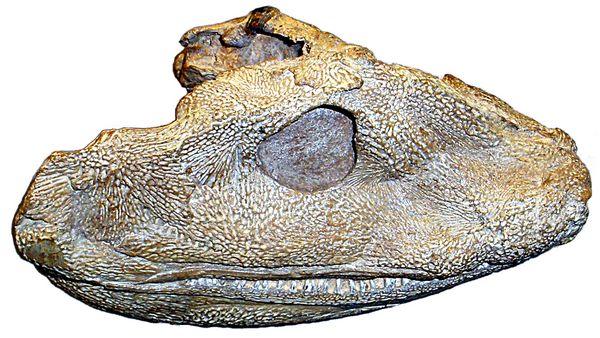Athena Review Image Archive ™
Acanthostega gunnari skull

Skull of Acanthostega gunnari (AMNH cast; photo Athena Review)
Acanthostega gunnari was an early tetraform lobe-finned fish found in East Greenland, dating from the Late Devonian, Famennian phase (365 mya). Acanthostega means "spiny roof" (acantho- "spiny; -stega "roof") , referring to its skull features; gunnari stands for one of the discoverors, Gunnar Save-Soderberg. One of the first known tetrapods, Acanthostega descended from lobe-finned fish known as Sarcopterygians.
Acanthostega was discovered in 1933 in Greenland by Save-Soderberg and Eric Jarvik. In 1987 Jennifer Clack found and published more complete examples in the same East Greenland formation. These show that Acanthostega had well-developed limbs, with an unusual array of 8 digits on its hands and feet. Acanthostega was mainly adapted to life in the water. It retained a fish-like shoulder, while its tetrapod (amphibian-like) features included a humerus, radius, and ulna.
It had a middle ear with a stapes that was used as part of a kind of spiracle for respiration, rather than as an ossicle in hearing as the stapes later became used in reptiles and synapsids. Like Ichthyostega, another tetraform found by Save-Soderburgh in the same Greenland rock formation, Acanthostega also had functional internal gills as adults.
References:
Clack, Jennifer 2012. Gaining Ground. University of Indiana Press.
.Copyright © 1996-2020 Rust Family Foundation (All Rights Reserved).